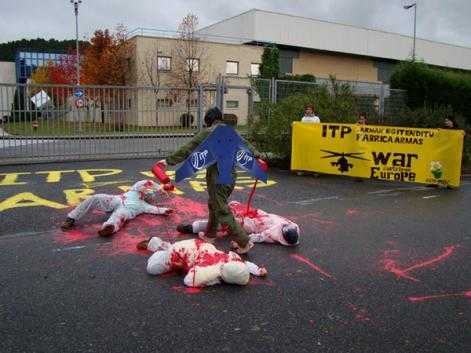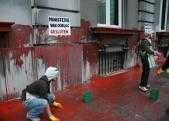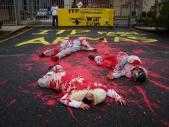War Starts from Europe - Decentralised Day of Action 14 – 15 of November 2008
On 14-15 November, antimilitarist nonviolent actions took place in a number of countries around Europe, as part of the a European Day of Action against military infrastructure. The day of action was another step in the coordinated work of radical nonviolent antimilitarist groups in Europe.
This loose network has had other two main activities this year. First, in March in Brussels, NATO Game Over, organised by the Belgian group Vredesactie, saw 1000 people trying to cross the fences of the headquarters of NATO. The other highlight this year was the European Peace Action Forum, which took place at the same time as the European Social Forum in September in Malmö, hosted by the Swedish antimilitarist group, Ofog.
These activities had the aim to denounce the role Europe plays in military interventions around the world and demand an end to the militarisation of Europe. One of the clearest examples of this militarisation is the intervention in Afghanistan, where more than 25,000 European soldiers are deployed as part of their contribution to NATO. Some of these countries are also involved in Iraq, either directly by sending troops or else by providing equipment used by the US military.
During both events, groups discussed how to continue the cooperation and coordination of activities at a regional level, so a series of activities were planned. These included activities that groups could do locally and also activities where the groups will come together and do an action or and event together. As part of the work to be done locally, it was decided to have a decentralised day of action against European military infrastructure, the date set was 14-15 November 2008.
Some of the actions
Most of the actions focused on institutions, corporations or infrastructure used for the military interventions in Afghanistan and Iraq. They were nonviolent actions, many of them civil disobedience.
For full reports on the actions you can go to: http://europeanpeaceaction.org
Dis-embedding mercenary scientists in Berlin
On 12 November 15 antimilitarists went to the institute of political sciences OSI at the Free University Berlin to "dis-embed" some mercenary scientists, who work in a special research group called "SFB 700". Under the neutral sounding focus "Governance in areas of limited statehood" the group provides support for the military interventions of the German army. The activists nailed bloody pillows to the doors of some of the most important scientists of SFB 700 and stuck their spokesperson into camouflage pillows that were pulled apart into small pieces, which made the feathers dance upon his cardboard nose. A science that accepts the framework set by military operations is itself a military institution and has to be shut down, argued the activists.
Antimilitarist crime scene inspection in Berlin
On 13 November a bus load of antimilitarist started for a day tour of information and "citizen inspections". First stop was the Berlin court, where three of them - Axel, Florian and Oliver - are accused of attempting to burn three trucks of the German army. The "inspectors" made it very clear that this has to be seen as an act of necessary disarmament. As this statement was made outside of the court in a rather loud way the judge had to interrupt his procedure.
Next the bus tour stopped for a Teach-In in the university of Potsdam where there exists a course called Military Studies. Students were protesting this direct cooperation of military institutes and university right from the beginning, but it still exists and can be seen as the spearhead of militarization of research and education in Germany.
Next stop was the MAN garage, where military trucks get repaired to be used in war again. After the attempt of Axel, Florian and Oliver to render them useless failed, the garage remains a crime scene and was therefore inspected by antimilitarists. Meanwhile a MAN military truck painted on paper was set on fire at the fence.
Before the 5 hour trip ended – in between the inspections the activists educated themselves about all kinds of different antilimilitarist initiatives, as well as about new strategies of the German army and NATO - the headquarter of the German army responsible for all foreingn deployments in Potsdam-Geltow was visited. A crime scene situated very discreetly in the middle of a little forest.
AA MOC of Alacant (Spain) enter a Radar Base and put the Flag of Peace
On 14th November, activists from AA MOC from Alcant climbed the doubly wired fences to trespass the military base. Once inside, they made their way up to the top of that beautiful mountain, and planted the Flag of Peace besides the geodesic vortex that indicates the highest point in the province, just besides an enormous dome protecting the radar of the base. That flag is a symbol of the disobediences practised against war and injustice, and a symbol, too, of the society they want to construct.
.
Swedish peace activists aim at Aimpoint
Early in the morning of 14 November, a number of Ofog activists went to Aimpoint AB in Malmö, Sweden, a producer of red dot sights used prolifically in war, for example in Iraq and Afghanistan. Martin Smedjeback, 35, did a quick weapons inspection before he was stopped by the police and taken aside. Annika Spalde, 39, also aimed to get over but was stopped by the police before she got the chance to get over the fence. Meanwhile the other activists held a vigil outside Aimpoint where they mentioned the names of about 20 of the many victims of the Iraq war.
“We Europeans make money from our wars in the global south. It is shameful to build wealth on such activities”, says Annika Spalde, a deacon in the Swedish Lutheran Church. Aimpoint has sold 400 000 red dot sights to the USA worth at least 240 million US dollars. These are mounted on the M16 and other common weapons in the US army. It is used in Iraq and Afghanistan.
Blockade of Belgian ministry of defence
A group of around 30 Belgian activists blocked the gates of the Ministry of Defence with chains and locked themselves to the entrances. They climbed the building to hang banners, while a crew of cleaners swept blood from the pavement in front of the building. Police forces were mobilised quickly after the start of the blockade. A special 'lock on team' intervened to remove the activists which had attached themselves to the entrances. All the activists were arrested.
Belgian cooperation in the war in Afghanistan is only one example of how our country is involved in wars elsewhere. The military transports from military bases in Germany via Antwerp's Harbour to war zones in Iraq and Afghanistan still continue.
Blockade action in ITP Basque weapon factory
On 15 November, activists from KEM-MOC Bilbao blockaded ITP (Industria de Turbopropulsores), one of the leading Basque factories which produces engines and turbines for the military industry, mainly military planes and helicopters. The activists blocked the door with chains and used red paint symbolizing the blood and destruction that the ITP products cause around the world. Among other military artefacts, ITP contributes to the Eurofighter 2000 Typhoon, Tiger HAD helicopter and Military transport Airbus. It does maintenance work for many armies all over the world, and among other models, ITP keeps operative the military helicopters Chinook and Superpuma, both of them now in use in Afghanistan.
Next Steps
The next steps of this regional coordination mainly focus on the summit for the 60th anniversary of NATO, which will take place in Strasbourg (France) and Baden Baden (Germany) on the 3-4 April 2009. Activities being prepared include a mass demonstration in Strasbourg on 4 April; a conference providing criticism and alternatives, civil disobedience and a camp for activists. Many of these activities are still at a preparatory stage. There will be an International Activist Conference in Strasbourg on the 14/15 of February 2009 to prepare the actions.
War Resisters' International is part of the coordinating committee for these events, so we will keep you updated about what its being planned.
During the European Peace Action Forum in Malmö it was also suggested to have another of these forums during the activities of the 60 anniversary of NATO. This decision needs a follow up and to see how it would fit with all the other events being prepared.
Finally on the resources side. There are three websites for the network to use:
- The revamped War Resisters International website provides the space for members of WRI to do their own posting.
- The McMilitary website http://mcmilitary.org should be the place for sharing resources around military infrastructure; and.
- The European Peace Action website http://europeanpeaceaction.org hosts reports from actions done by the different groups.
These are tools that only work if we use them, so please do!





Add new comment